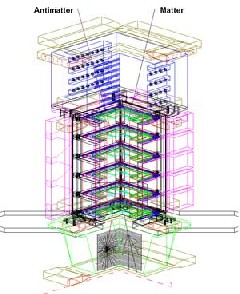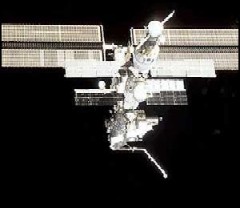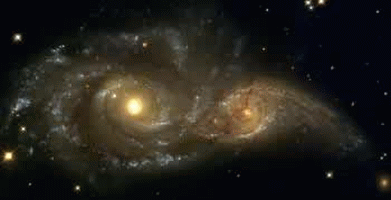Antimatter today in the Universe
Are we really sure that in some remote parts of the Universe there is no antimatter, including antistars and antigalaxies?
In the last 20 years a lot of research has been carried out using
increasingly sophisticated instruments. Given that, when antimatter collides with ordinary matter,
there are
annihilations![]() producing electromagnetic
radiations
producing electromagnetic
radiations![]() ,
scientists tried to detect antimatter via the produced electromagnetic radiations,
light in particular. Fig.1 shows the collision between two galaxies. They are not
one galaxy and one antigalaxy because, from the colliding region, we do not observe any extra light, annihilation of particles and antiparticles.
,
scientists tried to detect antimatter via the produced electromagnetic radiations,
light in particular. Fig.1 shows the collision between two galaxies. They are not
one galaxy and one antigalaxy because, from the colliding region, we do not observe any extra light, annihilation of particles and antiparticles.
This is confirmed by negative results from observatories on satellites, which
could detect high energy
photons![]() , called
gamma rays
, called
gamma rays![]() , with energies which would
correspond to those expected.
, with energies which would
correspond to those expected.
A different line of research tries to find heavy antinuclei
in primary
cosmic rays![]() . In order to avoid collisions of the antinuclei with the
nuclei
. In order to avoid collisions of the antinuclei with the
nuclei![]() of the atmosphere the instruments are installed on satellites. Two experiments in
particular are now searching for antimatter coming from outer space.
of the atmosphere the instruments are installed on satellites. Two experiments in
particular are now searching for antimatter coming from outer space.
PAMELA (Payload for Antimatter Matter Exploration and
Light-nuclei Astrophysics) will be installed on the Russian satellite Artica
and will search for medium energy antinuclei.
The AMS detector (Alpha Magnetic Spectrometer), to be installed in the
International Space Station, will search for antinuclei of medium and high energy.
 |
Fig. 2:
Diagram of the method used to detect
nuclei (matter) and antinuclei (antimatter) with the PAMELA spectrometer.
Nuclei and antinuclei coming from above will be curved by a magnet in
opposite directions. An antinucleus would then annihilate with matter
(bottom left) yielding an "event" with many tracks. (Credit: PAMELA experiment) |
 |
Fig. 3: The International Space Station where the
AMS experiment will be installed. (Credit: NASA) |
Protons and helium nuclei were produced in the first moments of the Universe. Instead heavier nuclei, like carbon, iron and all the others existing on Earth, were "cooked" inside some heavy stars, which later exploded and spread this matter in space. This matter was later included in the cosmic cloud from where our solar system was born. We therefore think that if we find even only few anti-carbon or anti-iron antinuclei this would prove that there are regions in space where antistars exist.
